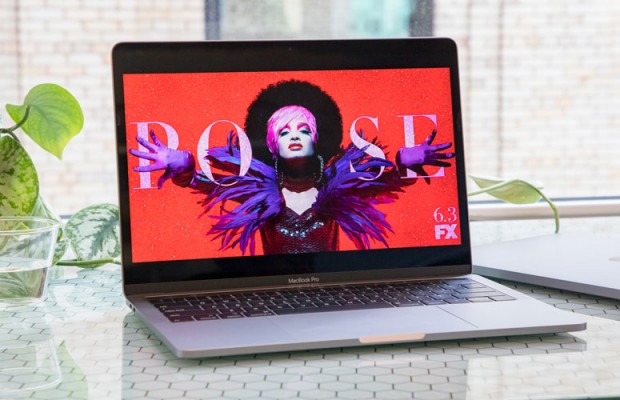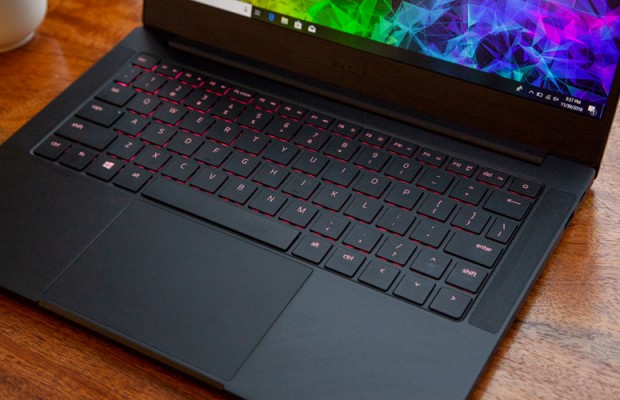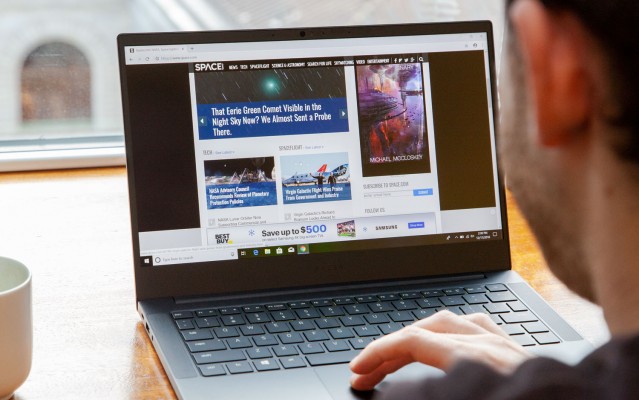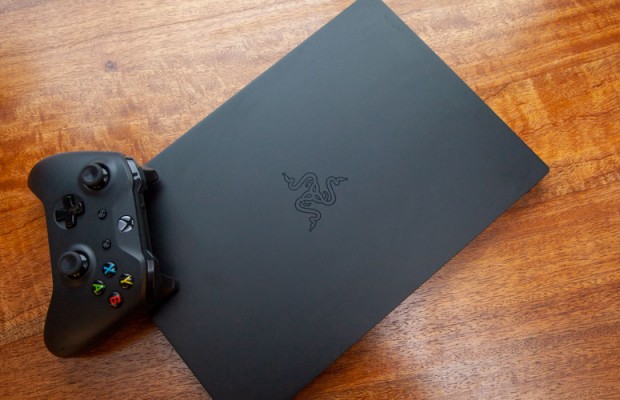Razer Blade Stealth vs. MacBook Pro: Why Razer Wins
Razer made a number of improvements to the new Blade Stealth, the company's most portable and least expensive ultrabook. The sleek laptop not only packs an optional dedicated GPU, but battery life has been improved by several hours over its predecessor. These changes alone make the Blade Stealth a compelling competitor to some of our favorite 13-inch notebooks, including the MacBook Pro.
Can the latest Blade Stealth hold its own against Apple's highest-end laptop? Read on to find out.
Razer Blade Stealth vs. Apple MacBook Pro: Specs compared
| Row 0 - Cell 0 | Razer Blade Stealth | Apple MacBook Pro (13-inch) |
| Starting Price (as configured) | $1,399 ($1,599) | $1,199 ($2,499) |
| Colors | Black | Silver, Space Gray |
| Display | 13.3 inches, 1080p or 4K | 13.3 inches, 2560 x 1600 pixels |
| CPU | Intel Core i7-8565U | Intel Core i5, i7 |
| RAM | 8GB, 16GB | 8GB, 16GB |
| SSD | 256GB, 512GB | 256GB, 512GB, 1TB, 2TB |
| Key Travel | 0.8mm | 0.6mm |
| Ports | 2 USB 3.1, 2 Thunderbolt 3, headphone | 4 Thunderbolt 3 |
| Webcam | 720p | 720p |
| Geekbench 4.0 | 15,878 | 17,348 |
| Battery Life (hrs:mins) | 8:05 (FHD) | 8:43 |
| Weight | 2.9 pounds | 3 pounds |
| Size | 12 x 8.3 x 0.6 inches | 12 x 8.4 x 0.6 inches |
Design
The Stealth lives up to its name this year, with a stylish matte obsidian finish and subtle black logo, which replaces the loud glowing-green emblem of its predecessor. The corners of this 13.3-inch laptop are slightly rounded, and the display bezels are agreeably narrow. On the deck sits a large touchpad and two top-firing speaker grills.
The MacBook Pro hasn't changed much over the years. The latest model looks identical to its predecessor, which isn't necessarily a bad thing. The all-aluminum MacBook Pro still has one of the more premium designs available, and the Touch ID sensor makes it easy to log in. But the Stealth matches that premium build and the large touchpad of the MacBook Pro and tops it with a decidedly more elegant paint job and slimmer display bezels.
Sign up to receive The Snapshot, a free special dispatch from Laptop Mag, in your inbox.
These two clamshell notebooks have practically the same footprint, but the Razer laptop is a tad lighter, at 2.9 pounds, compared with the 3-pound MacBook Pro.
Winner: Blade Stealth
Ports
There aren't a ton of ports to choose from with either of these slim laptops, but we prefer the wider selection offered by the Blade Stealth.
Both sides of the Razer laptop house a USB 3.1 (Type-A) port and a Thunderbolt 3 port. The only other input is a headphone jack on the left side.
Apple went all-in on Thunderbolt 3, including four of these modern ports (two on each side) on the MacBook Pro. Just like the Razer Blade, a 3.5mm input is the only other port you'll find.
Winner: Blade Stealth
Display
Although we enjoyed the rich images captured on the Razer Blade's matte, 1080p display, the MacBook Pro's glossy screen is brighter and more detailed.
The Razer Blade's 13.3-inch FHD display covers 120 percent of the sRGB color gamut, which just barely tops the MacBook Pro's 119 percent. Both panels edged out the premium laptop average of 117 percent.
Not only does the 13.3-inch, 2560 x 1600-resolution screen on the MacBook Pro have more pixels than the screen on the Razer, it's also a good deal brighter. The Blade Stealth's peak brightness of 346 nits is radiant — topping the premium laptop average (317 nits) — but the MacBook's panel is extremely luminous, at 439 nits.
If you want the sharpest display or touch sensitivity, the Blade Stealth is the only notebook of the two to offer a 4K touch-screen option.
Winner: MacBook Pro
Keyboard and Touchpad
The keyboard is where Apple and Razer made compromises to keep their laptops so slim. Key travel on the Blade Stealth (0.8mm) and MacBook Pro (0.6mm) stops well short of our 1.5 to 2mm preference, meaning heavy typists will need to be extra careful not to bottom out.
One of our biggest cons with the Blade Stealth is that the Shift, Enter and Backspace keys on its island-style keyboard are undersize. As a result, there is a bit of a learning curve to making sure you tap the right key every time. In contrast, the MacBook Pro's keys are large and well-spaced.
On a positive note, the Stealth's springy key feedback and an ideal 67 grams of actuation force kept my fingers comfortable during a long typing session. I typed 117 words per minute with an accuracy of 95 percent on the 10fastfingers.com typing test. For comparison, I typed slower and with more errors on the MacBook Pro's shallower keyboard (103 wpm, 9 percent error rate).
MORE: Laptops with the Best Productivity Performance
The Razer Blade earns some style points for its beautiful Chroma RGB lighting, whereas the MacBook Pro's keys illuminate with a more traditional white light.
If a large touchpad is important to you, then you'll be glowing when you see the deck of these laptops. The MacBook Pro's massive 5.3 x 3.3-inch trackpad is one of few that is larger than the 4.3 x 2.8-inch surface on the Blade Stealth. Both touchpads are extremely fluid and responsive, and we didn't have any issues performing multifinger gestures on them.
Winner: Blade Stealth
Performance
The Blade Stealth is one of the fastest 13-inch laptops we've tested, but it can't dethrone the MacBook Pro.
Equipped with the latest Intel Core i7-8565U Whiskey Lake CPU, the Razer laptop scored an excellent 15,878 on the Geekbench 4 overall performance test, beating the premium average (14,180) by a wide margin. The 8th Gen Core i7 CPU in the MacBook Pro outperformed the Razer, with a score of 17,348.
The Razer fought back on our the Excel Spreadsheet test, matching 65,000 names with their corresponding addresses in just 21 seconds. That time crushes the time achieved by the premium laptop average (1:31) and the MacBook Pro (1:16).
Our File Transfer Test is where the MacBook Pro distances itself from the Razer Blade — and every other consumer laptop we've ever tested. The 256GB NVMe SSD inside the MacBook Pro 13 duplicated 4.97GB of mixed-media files in 2 seconds for a blistering pace of 2,519 megabytes per second. The Stealth's 256GB PCIe NVMe M.2 SSD needed 20 seconds to complete the same task for an underwhelming transfer rate of 254 MBps.
The MacBook Pro also did an excellent job on our Handbrake test, which involves converting a 4K video into 1080p. The Apple laptop's time of 14 minutes and 47 seconds is nearly 6 minutes faster than what the Blade Stealth (20:34) needed. To its credit, the Stealth did outpace the premium laptop average (21:57).
MORE: Laptops with the Best Overall Performance
Razer is best known for its gaming hardware so it's only fitting that the Razer Blade Stealth, which packs an Nvidia GeForce MX150, dominated our graphics tests. The Stealth ran the racing game Dirt 3 at a buttery-smooth 164 frames per second, leaving the MacBook Pro 13 (47 fps) in the dust.
Winner: MacBook Pro
Battery Life
While other 13-inch laptops last several hours longer on a charge than the MacBook Pro and the Blade Stealth, these two powerful machines will get you through almost a full day of work.
The Blade Stealth improved upon its predecessor, lasting for 8 hours and 5 minutes on the Laptop Mag Battery Test, which involves continuous web surfing over Wi-Fi at 150 nits of brightness. The MacBook Pro retains the better-than-average (but not exceptional) battery life of the 2017 model, enduring for 8 hours and 43 minutes on our test.
Winner: MacBook Pro
Value and Price
It's time to save up. These are two of the most expensive 13-inch consumer-focused laptops on the market. While you get what you paid for, an argument could be made that these two laptops aren't a great value compared with cheaper rivals like the $999 Dell XPS 13 or the Surface Laptop 2.
The base FHD Blade Stealth starts at $1,399 for a Core i7-8565U CPU with 8GB of RAM, a 256GB SSD and an Nvidia GeForce MX150 GPU with 4GB of VRAM. Spending another $200 will bump up RAM to 16GB, while splurging on the 4K model adds an additional $300 to your receipt.
The new 13.3-inch MacBook Pro with TouchBar is exorbitantly priced. For $1,799, you get a Core i5 CPU, 8GB of RAM and a 256GB SSD. You'll need to spend two grand if you want 512GB of storage. The $2,499 model we reviewed included a Core i7 CPU, 16GB of RAM and a 512GB SSD.
Winner: Blade Stealth
Overall Winner: Razer Blade Stealth
| Row 0 - Cell 0 | Razer Blade Stealth | Apple MacBook Pro |
| Design (10) | 9 | 8 |
| Ports (10) | 6 | 5 |
| Display (15) | 12 | 13 |
| Keyboard/Touchpad (15) | 6 | 5 |
| Performance | 16 | 18 |
| Battery Life (20) | 14 | 15 |
| Value (10) | 5 | 3 |
| Overall (100) | 68 | 67 |
This was an extremely close fight, but the narrow decision goes in favor of the Razer Blade Stealth. Razer's ultraportable laptop edges ahead of the MacBook Pro with its classier design, wider range of ports and lower price tag. Furthermore, the Blade Stealth is one of few 13-inch laptops that can be configured with a dedicated GPU for casual gaming.
The MacBook Pro may have lost this battle, but it is still a great choice for most users. Apart from running macOS, the MacBook Pro separates itself from the Blade Stealth with outstanding performance and slightly longer battery life.
Overall, the Blade Stealth is a better laptop overall than the MacBook Pro, if only by a razor-thin margin.
Credit: Laptop Mag
Phillip Tracy is the assistant managing editor at Laptop Mag where he reviews laptops, phones and other gadgets while covering the latest industry news. After graduating with a journalism degree from the University of Texas at Austin, Phillip became a tech reporter at the Daily Dot. There, he wrote reviews for a range of gadgets and covered everything from social media trends to cybersecurity. Prior to that, he wrote for RCR Wireless News covering 5G and IoT. When he's not tinkering with devices, you can find Phillip playing video games, reading, traveling or watching soccer.











